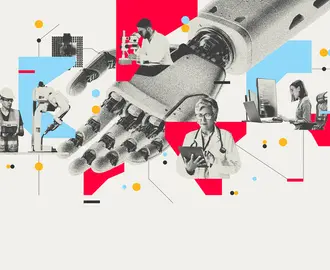Credit: Viktoria Kurpas / Shutterstock
How to break the ‘AI hype cycle’ and make good AI decisions for your organization
It’s an artificial intelligence hype cycle Robert Blumofe sees far too often: Business leaders hear an anecdote about an early-stage AI breakthrough, mistake it for a mature use case, fear that they’re missing out, plunge headlong into adoption — and end up with an implementation that falls short of expectations.
“That’s the chain: AI success, theater, FOMO, and some form of failure,” the Akamai executive vice president and chief technology officer said at the MIT Technology Review EmTech AI conference. “I’m seeing that happen again and again.”
In his presentation, Blumofe used Akamai’s AI evolution as an example of how business leaders can break the hype cycle and build AI fluency across their organizations.
Employee engagement should be at the center of this strategy, he said. Earlier this year, a survey conducted by Pew Research found that about 1 in 6 U.S. workers use AI to do their job in some way, compared with some 81% who do not.
Blumofe, who holds a PhD in computer science from MIT, sees low AI adoption as a missed opportunity. “Most jobs at this point can benefit from AI,” he said. “It’s a matter of which tasks can most benefit, and how, [using] which form of AI.”
He offered four tips for business leaders striving to help their organization attain AI fluency.
Don’t overinvest in large language models
Too many people think of AI solely in terms of large language models, which are trained on trillions of parameters, when in fact purpose-built AI models are better suited for addressing specific tasks. Akamai, for example, has deployed many custom models for identifying and analyzing potential cybersecurity threats.
“In many ways, an LLM is a ridiculously expensive way to solve certain problems. It’s rare in an enterprise that you need a trillion-parameter model covering … every event in history,” Blumofe said. “One of the lessons from DeepSeek is that you can do a lot more with less,” he said, referring to the Chinese startup whose AI models are less expensive and less compute-intensive than U.S. competitors.
Don’t let LLM success cloud your judgment
An LLM is well suited for something like classifying email, but that is “success theater,” Blumofe said. Most enterprise problems require more complex solutions beyond writing clever prompts to organize basic forms of structured data.
In most cases, LLMs are one part of an “ensemble of technologies” that come together for a purpose-built solution. Along with its models for cybersecurity threat hunting, for example, Akamai has developed a chatbot that answers employees’ questions about migrating customers to a new platform, and a tool that writes responses to vendor and customer requests for proposals.
Explore the world of AI beyond LLMs
Maturing beyond the one-size-fits-all approach of using LLMs means looking at technology more holistically. That means knowing when approaches like deep learning (to recognize patterns) or symbolic AI (to craft logical responses) are a better bet. “There’s a whole world of AI beyond LLMs,” Blumofe said. “I would argue these models are in many ways more likely to offer enterprise value over the longer term.”
Let employees experiment
Akamai has built an internal sandbox to “allow everybody to do their own thing and play with AI,” Blumofe said. That approach contrasts with that of enterprises that select a handful of AI pilots from a list of dozens of proposals. Akamai’s IT team may cry uncle at some point, given bandwidth use and computing costs, Blumofe conceded — but until that happens, he said, he feels no need to evaluate each possible AI use case.
At the end of his talk, Blumofe fielded a question from an audience member about companies like Shopify and Duolingo that are requiring hiring managers to prove that AI cannot do a job before they hire a human for the role.
Such companies are “getting the tail before the dog,” Blumofe said. “The burden of proof should go the other way. What’s the problem you’re trying to solve? What’s the right technology? If it’s AI, that’s great — but I don't think the burden of proof should be on ‘Why not AI?’”

Leading the AI-Driven Organization
In person at MIT Sloan
Register Now




